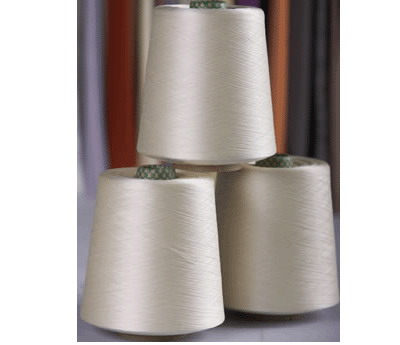Spun Silk takes the following process route:
1. Degumming the silk waste: It is done in degumming vats.
2. Dryers for drying the degumming material.
3. Openers for opening the fibres.
4. Fillers for opening and cleaning the material.
5. Dressing machine is used for combing the materials neps and remove the foreign materials, neps and short fibre and make a lap with average steple length.
6. Spreader : To further make the fibers parallel. Set frames for obtaining sliver.
7. Draw frame is used for making the Sliver with fibres more perfectly paralised, blending also can be done by this machine.
8. Roving machine for making roving (standard of thread with little twist from silver).
9. Ring frame is used for making the spun yarn from roving and insert sufficient twist for strength and wind in a bobbin.
10. Winding & doubling machine are used for two or three fold commercial yarn.
11. Gassing is done for removing the protruding fibres by passing the yarn through the flame at a speed 500-600 mts/min.
12. Reeling to make standard sized hank.
13. Bundling & Balling : First make a bundle and bale for disposal of the material.
1. Degumming the silk waste: It is done in degumming vats.
2. Dryers for drying the degumming material.
3. Openers for opening the fibres.
4. Fillers for opening and cleaning the material.
5. Dressing machine is used for combing the materials neps and remove the foreign materials, neps and short fibre and make a lap with average steple length.
6. Spreader : To further make the fibers parallel. Set frames for obtaining sliver.
7. Draw frame is used for making the Sliver with fibres more perfectly paralised, blending also can be done by this machine.
8. Roving machine for making roving (standard of thread with little twist from silver).
9. Ring frame is used for making the spun yarn from roving and insert sufficient twist for strength and wind in a bobbin.
10. Winding & doubling machine are used for two or three fold commercial yarn.
11. Gassing is done for removing the protruding fibres by passing the yarn through the flame at a speed 500-600 mts/min.
12. Reeling to make standard sized hank.
13. Bundling & Balling : First make a bundle and bale for disposal of the material.
The size of spun silk thread is defined in a similar manner to standards used for cotton yarn. For cotton, the term "2/60s"signifies a two-ply yarn consisting of two single strands twisted together, each having a yearn count of 60.
In the case of spun silk the notation has a different meaning. For example, for 60/2 two yearns with a separate yarn count of 120 have been doubled, producing a ply yarn with a new count of 60. (Source)
Spinning of Tussar
Tassar silk waste is degummed by boiling in a pressurised tank with soap and soda for 30 min and treated with sodium sulphite for partial bleaching. However, to remove gummy matter completely, the material is subsequently kept in a soap and soda solution in a large wooden tank for 3-4 days. After degumming the material is fresh water, hydro extracted and subsequently dried in hot air chambers. The degummed tassar waste is then processed through a series of operations which includes opening, filling, dressing or combing, spreading, drawing, gill roving, spinning and gassing. Mill spun tassar yarn in the range of 60-210s (metric count) can be produced. The yarn is then doubled and twisted according to the required specifications.(Source)
Thanks for your attention. Did you find the information you were looking for ? Please leave a comment. Do you need to know more ? Please suggest a topic in the comments. You can also join the Forum for your specific queries.
